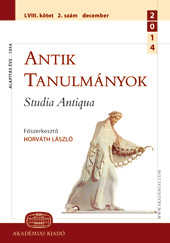Héliodóros és a Makkabeusok, avagy adalékok a Héliodóros-kronológiához
Heliodorus and the Makkabeans, or additives to the Héliodorus chronology
Author(s): Tibor SzepessySubject(s): Ancient World, History of Judaism, Greek Literature, Theory of Literature
Published by: Akadémiai Kiadó
Keywords: war elephants; armoured cavalry (the kataphraktoi); oxymoron; chronology of Heliodoros;
Summary/Abstract: There are two remarkable parallels between the Maccabees first two books and ¸ Heliodoros’ novel. Th e first one (1Mac 6, 43–47 ~ Hel. 9, 17–18) is of content character, it visualizes the seldom applied method used in the ancient world to frustrate the war elephants and the armoured cavalry (the kataphraktoi), and which other ancient sources also refer to (Plut. Crassus 25, 8). The second parallel is a double oxymoron: “to sail on the mainland, to go on foot on the sea” (2Mac 21 ~ Hel. 9, 5, 5), but versions of this phrase can be found in the works of a number of other ancient Greek and Latin authors (Isocr., Paneg. 89, 1, 8, Curtius Rufus, Hist. Alex Magni 9, 21, 4–6; Iamblichos, frg. dubia no. 101 Habrich, p. 73; Polemon, decl. 1, 8 and 28, decl. 2, 44; Achilleus Tat. 4, 14, 7–8; Lucian, Rhetorum praeceptor 18, 17–18; Iulianus, or. 1, 22, 10–16). Greek and Latin authors resort to oxymoron only if the obvious absurdity in it seems them still to be viable somewhere somehow. Iulianus and Heliodoros see and make us see the circumstances of storming towns an oxymoron that came true; Iulianus relate a historical event, the storming of Nisibis in 350 A.D., and because in Heliodoros’ novel the siege of Syene (9, 1, 1 sqq.) is in many respect similar to the emperor’s story, many researchers believe 350 A.D. to be a decisive date in regards of the chronology of Heliodoros, as well. However, the obvious popularity of the oxymoron leaves the possibility open namely that Heliodoros deduced a series of events from the oxymoron relying on his own invention, without a historical example, in other words that it could have worked in the first half of the 3rd century.
Journal: Antik Tanulmányok
- Issue Year: 56/2012
- Issue No: 2
- Page Range: 215-232
- Page Count: 18
- Language: Hungarian
- Content File-PDF

